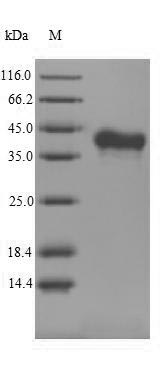Amino acids 70-316 form the expressed segment for recombinant Mouse Tnfsf11. The calculated molecular weight for this Tnfsf11 protein is 43.9 kDa. This Tnfsf11 protein is produced using e.coli expression system. The Tnfsf11 coding gene included the N-terminal 6xHis-SUMO tag, which simplifies the detection and purification processes of the recombinant Tnfsf11 protein in following stages of expression and purification.
Tumor necrosis factor ligand superfamily member 11 (Tnfsf11), also known as RANKL, is a key cytokine involved in the regulation of bone metabolism. It plays a crucial role in the differentiation and activation of osteoclasts, the cells responsible for bone resorption. RANKL binds to its receptor RANK on the surface of osteoclast precursors, triggering a signaling cascade that promotes osteoclast formation, function, and survival. Additionally, RANKL is essential for various physiological processes, including the development of lymph nodes and the mammary gland. Research on Tnfsf11 spans multiple areas, such as bone biology, immune system regulation, and reproductive physiology. In bone biology, investigations focus on understanding how RANKL signaling influences bone remodeling and its implications for diseases like osteoporosis and arthritis. In the immune system, RANKL is involved in the regulation of lymphoid tissue development and the immune response. Moreover, studies exploring the role of RANKL in reproductive physiology highlight its importance in mammary gland development and lactation. Targeting the RANKL/RANK pathway has therapeutic potential for bone-related disorders.






